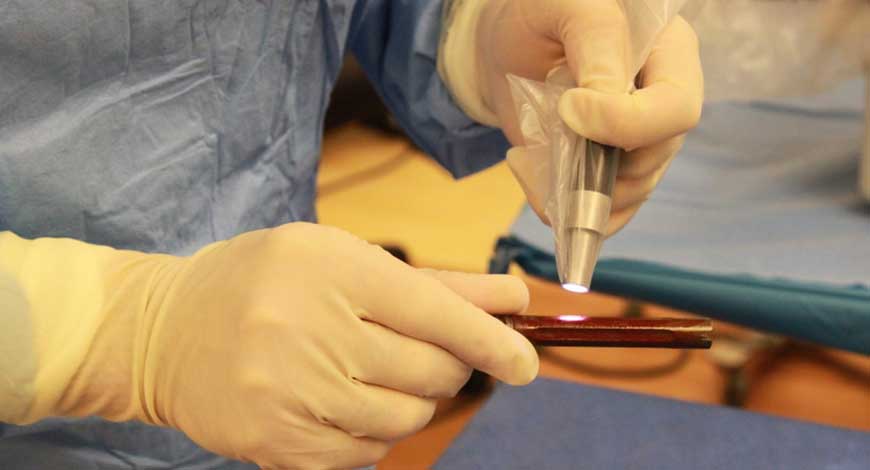Trends
New antimicrobial coating prevents contamination of medical devices

A new antimicrobial coating could go a long way in keeping medical devices free of infection-causing microbes after winning FDA de novo approval for its first indication.
Device developer Orthobond says its proprietary Ostaguard antimicrobial coating offers a new defense against bacteria, viruses and fungi that could contaminate the surface of an implantable device before it’s placed inside a patient.
The initial FDA approval is for Ostaguard-coated pedicle screws used in spinal fusions, but Orthobond said it has other devices treated with the technology in various stages of the regulatory process. Orthobond CEO David Nichols said the technology could eventually be used on a much wider range of orthopedic, oncology, neurovascular, plastic surgery and cardiac devices, or anywhere else infections are a concern.
In an exclusive interview with Medical Design & Outsourcing, Nichols — a former Zimmer Biomet executive — explained how Orthobond’s Ostaguard antimicrobial coating works and how other device developers might be able to take advantage.
Now that it has FDA approval, Orthobond plans to scale up manufacturing to meet demand and to submit a master file with the FDA to accelerate regulatory review for other device developers who want to use the technology on their products.
How Orthobond’s Ostaguard antimicrobial coating prevents contamination
Orthobond was founded by Princeton University Chemistry Professor Emeritus Jeffrey Schwartz and the late Dr Gregory Lutz. Schwartz was trying to use the ability to bond to the oxide layer for automotive tires and saw an opportunity for osteoconductivity.
While that application didn’t outperform existing options, their research yielded an incredibly strong covalent bond that could prevent quaternary ammonium molecules (also called quats) from eluting into a patient’s body.
Orthobond covalently bonds its antimicrobial, polycationic molecules to the surface of an implant before packaging and sterilization.
It’s a wet chemistry process in which a medical device such as a hip, knee or screw is dunked in a chemical bath and then heated in an oven. That bonds a phosphonic acid layer only 4 or 5 nanometers thick to the oxide on the surface of the implant. Then an approximately four-hour polymerization process attaches quaternary ammonium molecules with densely packed, positively charged nitrogen at the end of the chain.
The resulting layer of positively charged, quaternary ammonium molecules on an implant’s surface measures only one-millionth of an inch and immobilizes, perforates and destablizes microbes.
“It’s like flypaper because bacteria is negatively charged and our surface is positively charged,” Nichols said. “It actually draws them to our surface, puts little pin pricks in the bacteria and starts the death process. As they try to move around, it breaks them apart and kills them.”
FDA records describe the coating as a 12-methacryloyloxydodecyl pyridinium bromide (C21H34BrNO2) compound.
Because the technology neutralizes microbes mechanically, it even works on antibiotic-resistant bacteria like the Mu50 strain of methicillin-resistant Staphylococcus aureus (MRSA), which has evolved efflux pumps to remove antibiotics from its cells and render them ineffective.
“Our surface will kill that,” Nichols said.
The Ostaguard antimicrobial coating kills common infection-causing microbes such as Staphylococcus aureus, Pseudomonas aeruginosa, E. coli, methicillin-resistant Staphylococcus aureus (MRSA), E. cloacae and C. acnes.
The coating technology has not been evaluated in human clinical trials, but Orthobond said it found no evidence of local or systemic toxicity in sheep, guinea pig and canine testing.
Antimicrobial coating know-how for device designer and engineers
The company plans to keep the technology inside its facility to maintain proprietary control instead of licensing it for device manufacturers to use on their own production lines. The process currently takes two or three days before the treated products are packed, sterilized and sent back to the manufacturer (or shipped directly to the manufacturer’s packaging and sterilization provider).
“It adds a step in the supply chain, but most of that’s outsourced anyway,” Nichols said. “You can imagine a major medical devicemaker would manufacture it, clean it, ship it to be treated, and then it goes to sterile packaging from there.”
Applications for the antimicrobial coating permanent include all sorts of implants, but also catheters, surgical instruments, and dialysis machines.
The coating is compatible with all medtech metals, including cobalt chrome, stainless steel, titanium. Orthobond has also experimented with the coating process for different materials, such as a product with silicone epoxy that required a lower temperature, and a spray method for electronics that can’t be dipped in a fluid bath.
“Anything with an oxide layer’s easy: titanium oxide, chromium oxide,” Nichols said. “For the epoxy, we had to put an oxide layer on, so we put a layer of zirconium oxide on and then we put our chemistry on, so we’ve figured out the epoxy and the silicone.”
Teflon — like you’d find on some heart valves, for instance — is still a challenge, “but my chemists love that,” he said. “They say they can do it, but we have not done that yet.”
Nichols said the Ostaguard antimicrobial coating “holds up really well to gamma” sterilization, but applying the coating to devices sterilized with ethylene oxide or steam requires some fine-tuning.
Regulatory strategy is probably the biggest consideration for device engineers and designers who might want to use the antimicrobial coating, Nichols said. Using breast implants as an example, he said a devicemaker might want to start with a Class II breast tissue expander because the regulatory pathway would be easier than Class III breast implants.
Nichols said one area for improvement is application efficiency. Coating permanent implantables with a fluid bath results in a lot of waste, but the cost is insignificant if you’re using it for an artificial hip or knee joint. Orthobond will work to reduce the cost of application to make it a better fit for temporarily placed devices like catheters or reusable instruments.
“We’ve got to bring the price down probably tenfold, but it will work,” Nichols said.














